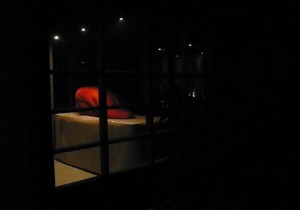I was thinking of Lavinia Greenlaw's London, that she described so eloquently in her last post: "I have spent most of my life between Keats and Rimbaud. Keats and Fanny Brawne met next to the library I used as a child. Rimbaud slapped Verlaine with a fish near the pool where I learnt to swim." Like a child, I contrasted this description of London —the Keats part—with what George Orwell had to say about Hayes, the part of London's industrial, tower-block orbital that I grew up in: "Hayes . . . is one of the most godforsaken places I have ever struck. The population seems to be entirely made up of clerks who frequent tin-roofed chapels on Sundays and for the rest bolt themselves within doors."
My latest work is set on the Hayes/Southall border and is a poetry of "Ban"—which is to say, non-being. I have spent most of the last two years writing the story of a girl who lies down on the sidewalk in the opening hours of what will become, by nightfall, a race riot. My London, Orwell's London—with a South-Asian (now Somali/Polish) flair—is the one with Mellow Lane Grammar School in it. Here, Orwell, slumming it, taught English literature and language to, presumably, the offspring of the upper working-class. I won a Scottish Dancing competition there, as part of a four person team from Grange Park Junior, in 1979. I wore a red and white checked dress and my traffic light knee socks: the left one was red and had the word STOP printed on it, in block capitals; the right one was green and said GO. My family lived in an end terrace with a coal chute in the garden and a rusted out, abandoned Morris Minor with a shattered windscreen propped against the back fence. Next door to us lived Stephen Whitby, a member of the National Front's youth league. With regularity, he'd empty out the milk bottles of our Gudjrati and Kenyan-Indian neighbors, filling them with an unrelenting supply of urine before putting them back on the doorstep. He must have woken before dawn to do this. Good job Margaret Thatcher banned free milk in schools when she took up her first cabinet position. Who knows what Stephen Whitby would have done.
I once heard Chris Abani give a talk on narrative and architecture; he talked about figuring out what the "unconscious of your city" was, then writing into that. I think of how a memory of a city is transmuted by migration, by schizophrenia, by social and domestic violence, by built environments of different kinds. I think about the Nestle factory. I think about the lilac, milky effluent in the Grand Union canal behind Southall Park, across the street where so many of our friends— Punjabi arrivals—lived. This, of course, is a long time ago; I was just in the UK and found myself flooded with joy at seeing ivy, brambles, cherry blossom trees and even a sky the color of paper as I passed through Hayes and Southall on the Heathrow Express.
Is nostalgia an endocrine act?
In writing about race events in a working-class section of London—a version of a city that rarely appears in contemporary poetry -- or, more loosely, experimental writing in any form—I've been thinking about Jonathon Velardi's installation at the Departure Gallery (in Southall) two years ago:

I wish I could use that as the title of my book: "Objects and Actions in the Abyss." The architectural platform—a Southall warehouse—used to stage these objects and actions: fills me with a parallel desire: to be staged.
Possibly there is something wrong with me.
I want, for example, to perform a sensorimotor sequence then return it to narrative. I want to place tiny glass mirrors in the ivy behind Ban's head. Thus, I stay with Ban—a dark-skinned girl walking home from school, a girl who lies down on the street rather than walk towards the riot's ambient sounds of breaking glass—or: to her home. I stay with her through the electro-convulsive twitches, a light rain and, as night falls, the sight of her body breaking up into dots: a form. To annotate: those micro-movements—the way each raindrop seems to leave an imprint, a dot of violet or black light upon her skin, skirt, blouse, socks and shoes. Does she have a face? Think about repetitive light touch, narrative and how a narrative of unremitting violence also has—the force to heal. Who is being healed? Is it invasive to propose "healing" as an objective for an account written, sustained and finally read as poetry? Is "Ban," for example, healed? No, she is not. She is killed off, a body just beyond society's vision. She emits pink, luminous flares. She is passive to the riot. She is killed off.
Meanwhile, I simply wanted to make the point that "my London" is (was) faceless and unromantic, to the max. All of this has made me intensely romantic as an adult. I don't know why. I felt, for example, considerable longing as I read Greenlaw's beautiful post. Once, visiting Keats' house, I slipped under the silky rope to lay a few minutes, in his bed.
My new dream is to write to the Departure Gallery and ask them if I can re-perform an historical event—the race riot of April 23rd, 1979—as a compound scene. I am not sure if I am a poet anymore. Sometimes I feel like meat slipping off a wet table instead. Sometimes I feel like the butcher. Sometimes I feel like the city. And sometimes I feel like everything at once, rotating and flexing on the butcher's table: right there in the window of my childhood home:

Bhanu Kapil was born in the United Kingdom and lives in the United States and the United Kingdom. She...
Read Full Biography

